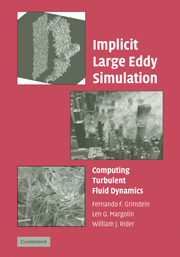Book contents
- Frontmatter
- Contents
- Preface
- List of Acronyms
- List of Contributors
- Introduction
- SECTION A MOTIVATION
- SECTION B CAPTURING PHYSICS WITH NUMERICS
- SECTION C VERIFICATION AND VALIDATION
- SECTION D FRONTIER FLOWS
- 14 Studies of Geophysics
- 15 Using PPM to Model Turbulent Stellar Convection
- 16 Complex Engineering Turbulent Flows
- 17 Large-Scale Urban Simulations
- 18 Outlook and Open Research Issues
- Index
- Plate section
16 - Complex Engineering Turbulent Flows
from SECTION D - FRONTIER FLOWS
Published online by Cambridge University Press: 08 January 2010
- Frontmatter
- Contents
- Preface
- List of Acronyms
- List of Contributors
- Introduction
- SECTION A MOTIVATION
- SECTION B CAPTURING PHYSICS WITH NUMERICS
- SECTION C VERIFICATION AND VALIDATION
- SECTION D FRONTIER FLOWS
- 14 Studies of Geophysics
- 15 Using PPM to Model Turbulent Stellar Convection
- 16 Complex Engineering Turbulent Flows
- 17 Large-Scale Urban Simulations
- 18 Outlook and Open Research Issues
- Index
- Plate section
Summary
Introduction
A grand challenge for computational fluid dynamics (CFD) is the modeling and simulation of the time evolution of the turbulent flow in and around different engineering applications. Examples of such applications include external flows around cars, trains, ships, buildings, and aircrafts; internal flows in buildings, electronic devices, mixers, food manufacturing equipment, engines, furnaces, and boilers; and supersonic flows around aircrafts, missiles, and in aerospace engine applications such as scramjets and rocket motors. For such flows it is unlikely that we will ever have a really deterministic predictive framework based on CFD, because of the inherent difficulty in modeling and validating all the relevant physical subprocesses, and in acquiring all the necessary and relevant boundary condition information. On the other hand, these cases are representative of fundamental ones for which whole-domain scalable laboratory studies are extremely difficult, and for which it is crucial to develop predictability as well as establish effective approaches to the postprocessing of the simulation database.
The modeling challenge is to develop computational models that, although not explicitly incorporating all eddy scales of the flow, give accurate and reliable flowfield results for at least the large energy-containing scales of motion. In general terms this implies that the governing Navier–Stokes equations (NSE) must be truncated in such a way that the resulting energy spectra is consistent with the |k|-5/3 law of Kolmogorov, with a smooth transition at the high-wave-number cutoff end. Moreover, the computational models must be designed so as to minimize the contamination of the resolved part of the energy spectrum and to modify the dissipation rate in flow regions where viscous effects are more pronounced, such as the region close to walls.
Information
- Type
- Chapter
- Information
- Implicit Large Eddy SimulationComputing Turbulent Fluid Dynamics, pp. 470 - 501Publisher: Cambridge University PressPrint publication year: 2007
